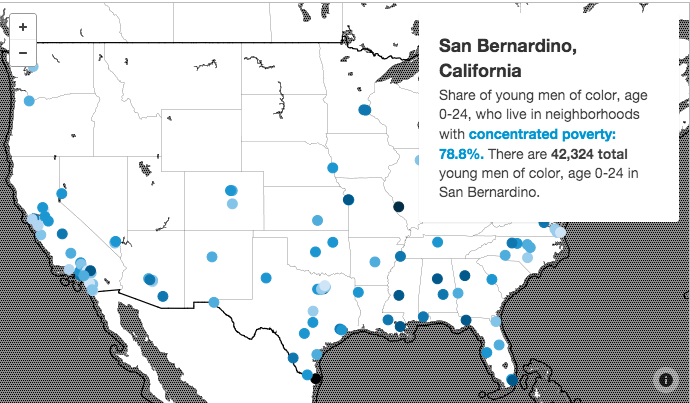Understanding the Challenges Faced by Boys and Young Men of Color
Resource type: News
Urban Institute | [ View Original Source (opens in new window) ]

INTERACTIVE MAP: Share of males, age 0-24 who live in areas of concentrated and deeply concentrated poverty. View map >
Boys and young men of color face profound challenges growing up in America. They are twice as likely to grow up in poverty as non-Hispanic white males and much more likely to live in neighborhoods of concentrated poverty. As they move through life, many face multiple educational and economic disadvantages, leaving African American and Hispanic males less likely than their white and Asian peers to have high school diplomas and more likely to be jobless.
Even boys and young men of color who don’t face as many disadvantages frequently find themselves negatively affected by social and cultural perspectives, institutions, and systems within the larger society. Understanding the larger context is essential to developing effective mechanisms for removing barriers that are created for boys and young men of color.
In the papers below, the Urban Institute has laid out the challenges faced by these boys and young men in several important areas and identified a number of policies, system reforms, and programs that could put them on course for successful transition to adulthood.
This research, which draws on a broad body of Urban Institute work, was done to inform philanthropic efforts that resulted in the report A Time for Action: Mobilizing Philanthropic Support for Boys and Young Men of Color. The report was released shortly after the My Brother’s Keeper Task Force announced its initial plan in May 2014.
Featured Research
- Understanding the Environmental Contexts of Boys and Young Men of Color
Lynette A. Rawlings - Promoting Healthy Families and Communities for Boys and Young Men of Color
Nan Astone, Susan J. Popkin, Heather Sandstrom, Lisa Dubay - Reducing Harms to Boys and Young Men of Color from Criminal Justice System Involvement
Akiva Liberman, Jocelyn Fontaine - Expanding Economic Opportunity for Young Men and Boys of Color through Employment and Training
Shayne Spaulding, Robert I. Lerman, Harry Holzer, Lauren Eyster
Criminal Justice
- Labeling Effects of First Juvenile Arrests: Secondary Deviance and Secondary Sanctioning
Akiva Liberman, David S. Kirk, KiDeuk Kim - Stop and Frisk: Balancing Crime Control with Community Relations
Nancy G. La Vigne, Pamela Lachman, Shebani Rao, Andrea Matthews - Evaluation of the Allegheny County Jail Collaborative Reentry Programs: Findings and Recommendations
Janeen Buck Willison, Samuel Bieler, KiDeuk Kim - Close-Range Gunfire around DC Schools
Samuel Bieler, Nancy G. La Vigne
Economic Opportunity
- The First Year of Accelerating Opportunity: Implementation Findings from the States and Colleges
Anderson, Theresa, Lauren Eyster, Robert I. Lerman, Carol Clymer, Maureen Conway, and Marcela Montes - Higher Education Earning Premium: Value, Variation and Trends
Sandy Baum - Final Report on the Evaluation of the National Science Foundation Louis Stokes Alliances for Minority Participation Program
Beatriz Chu Clewell, Clemencia Cosentino de Cohen, Nicole Deterding, and Lisa Tsui
Healthy Children and Families
- Exploring Instability and Children’s Well Being: Insights from a Dialogue among Practitioners, Policymakers and Researchers
Gina Adams, Lisa Dubay - Chronic Violence: Beyond the Developments
Chantal Hailey and Megan Gallagher - CHA Residents and the Plan for Transformation
Susan J. Popkin, Megan Gallagher, Chantal Hailey, Elizabeth Davies, Larry Buron, and Christopher Hayes - A Decade of HOPE VI: Research Findings and Policy Challenges
Susan J. Popkin, Bruce Katz, Mary K. Cunningham, Karen D. Brown, Jeremy Gustafson, and Margery Austin Turner
From the Urban Wire
- A perfect Mother’s day gift
Margaret Simms - Breaking down barriers to help boys and young men of color succeed
Margaret Simms - Tearing down barriers to success for young men of color
Nancy LaVigne - Millions of black students attend public schools that are highly segregated by race and by income
Reed Jordan - Many DC children are struggling to breathe. Is bad communication to blame?
Marla McDaniel - Helping Fathers Become Better Parents
Margaret Simms - To gauge the health of your whole community, look to your teens
Laudy Aron
Urban Institute is an Atlantic grantee.